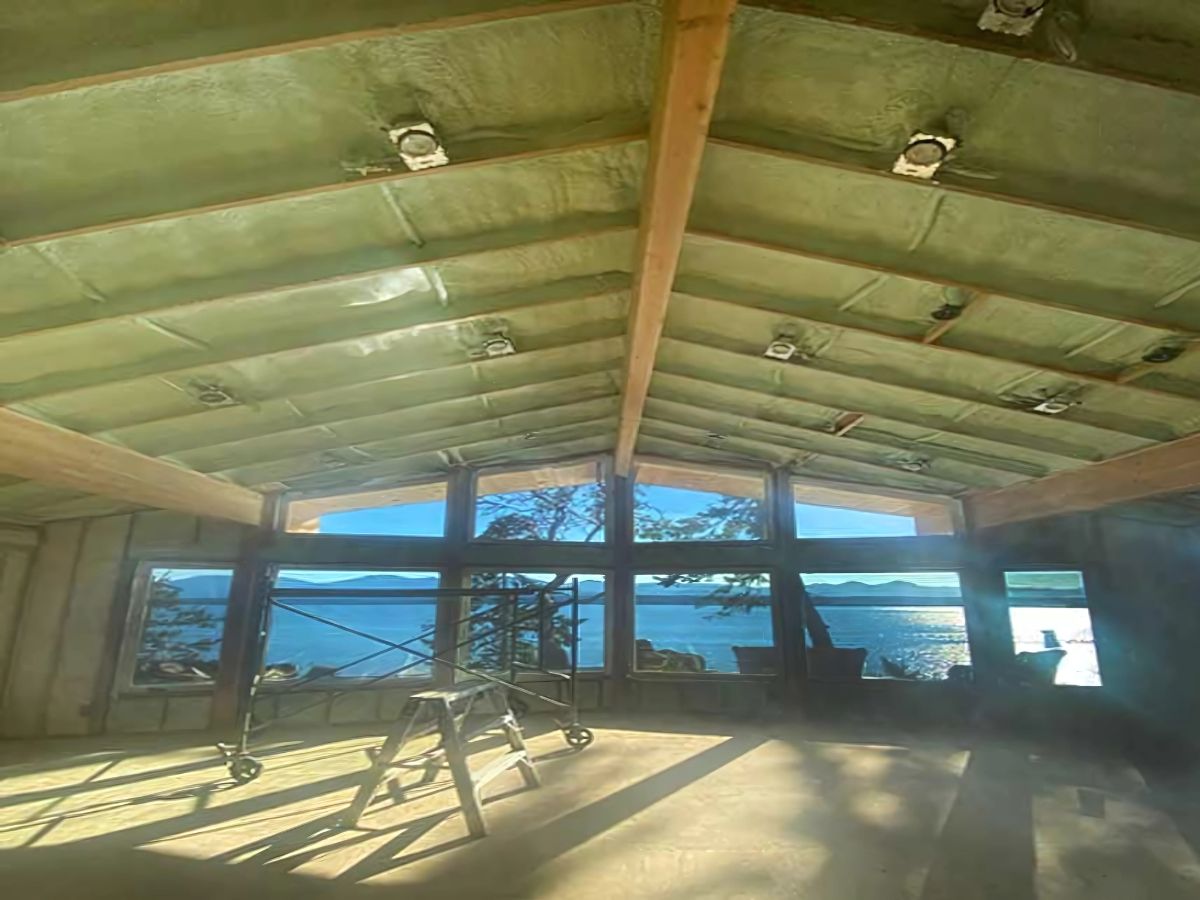Choosing the right insulation for your home isn’t just about energy savings; it’s about comfort, durability, air quality, and long-term value. One of the most debated topics in home insulation is closed cell vs open cell spray foam insulation. Both are powerful insulation materials, but they serve very different purposes. So, how do you know which one to choose?
As a trusted insulation contractor with years of experience serving homeowners across British Columbia and Alberta, we’ve installed both types in everything from small attics to commercial warehouses. We’ve seen what works, what doesn’t, and what offers the best return on investment.
Whether you’re renovating, building new, or upgrading your home’s efficiency, this guide will walk you through the difference between open cell spray foam and closed cell spray foam, their benefits, ideal use cases, and how to make the right decision based on your needs.
What Is the Difference Between Closed Cell Spray Foam and Open Cell Spray Foam insulation?
When it comes to spray foam insulation, both closed and open cell versions are made from similar base materials, but the final product behaves very differently due to the cell structure.
How does the structure of open cell spray foam compare to closed cell spray foam?
Open cell spray foam is soft, spongy, and expands significantly, up to 100 times its liquid volume. It has an open-cell structure, meaning the tiny foam bubbles (or cells) are not fully encapsulated, allowing air and moisture permeability.
Closed cell spray foam, on the other hand, is dense, rigid, and much more compact. The foam bubbles are completely sealed, creating a vapor barrier and high resistance to air and moisture.
Here’s a quick comparison:
| Feature | Open Cell | Closed Cell |
| Density | ~0.5 lb/ft³ | ~2.0 lb/ft³ |
| Expansion Rate | High | Moderate |
| Vapor Barrier | No | Yes |
| Air Seal | Yes | Yes |
| R-Value per Inch | ~3.5–4 | ~6.5–7 |
| Cost | Lower | Higher |
Which spray foam type is more suitable for different parts of the home?
- Open cell spray foam is ideal for interior applications: wall cavities, attics, and ceilings where moisture isn’t a primary concern.
- Closed cell spray foam excels in basements, crawl spaces, exterior walls, and areas prone to moisture or extreme temperatures.
What Are the Benefits of Using Open Cell Spray Foam in Your Home?
Open cell spray foam is often the more budget-friendly option, but that doesn’t mean it’s “less than.” It serves specific purposes exceptionally well.
Is open cell spray foam good for soundproofing and moisture control?
Absolutely. Because of its soft, sponge-like texture, open cell spray foam absorbs sound more effectively than its closed-cell counterpart. That makes it perfect for:
- Home offices
- Media rooms
- Bedrooms or nursery walls
However, it’s not a vapor barrier, so it won’t block moisture. You’ll need to pair it with a proper vapor retarder in humid environments.
Where should you use open cell spray foam for best results?
- Interior walls – great for sound control between rooms.
- Attics and ceilings – the high expansion rate helps fill nooks and gaps.
- Retrofit projects – its flexibility makes it ideal for irregular framing.
What Makes Closed Cell Spray Foam Ideal for High-Performance Insulation?
If you’re aiming for top-tier energy efficiency and moisture resistance, closed cell spray foam insulation is the gold standard.
How does closed cell spray foam resist moisture and add structural strength?
Closed cell foam acts as a moisture barrier, making it excellent for:
- Basements
- Crawl spaces
- Foundations
- Exterior walls
Its density not only resists water intrusion but also adds structural integrity to walls and roofing. In fact, some building codes now recognize it as a structural enhancement in hurricane- or storm-prone areas.
What is the closed cell spray foam insulation R-value, and why does it matter?
The closed cell spray foam insulation R-value is about 6.5 to 7 per inch, nearly double that of open cell foam. R-value is a measure of thermal resistance, and higher numbers mean better insulation performance.
This makes closed cell spray foam a great choice where space is limited, like in narrow wall cavities, and when maximum energy savings are the goal.
Closed Cell Spray Foam vs Open Cell Spray Foam: Which Offers Better Energy Efficiency?
Which type reduces heating and cooling bills more effectively?
Closed cell spray foam outperforms open cell when it comes to pure thermal resistance due to its higher R-value. It reduces air infiltration and heat transfer more aggressively, particularly in extreme climates.
Open cell spray foam still performs well, especially when used in the right location, but you may need more of it to reach similar thermal performance.
How does insulation R-value impact your long-term energy savings?
It’s simple: the higher the R-value, the more you save in energy costs. Over time, closed cell foam’s upfront cost can be offset by lower utility bills, especially in harsh winters or hot summers. You might see a 30-50% reduction in heating and cooling costs with proper application.
How Do Costs Compare Between Closed Cell and Open Cell Spray Foam?
Is closed cell spray foam worth the higher upfront cost?
Yes, in many cases, especially if you live in areas with moisture, temperature extremes, or plan to stay in your home long-term. Expect to pay $1.00 to $1.50 per board foot for open cell foam, compared to $1.75 to $3.00 per board foot for closed cell.
But remember, you often need less closed cell foam to reach the desired R-value, and it serves multiple roles (insulation + vapor barrier + air seal).
When does open cell spray foam make more financial sense?
If you’re insulating a large attic or interior walls where vapor resistance isn’t needed, open cell foam offers excellent performance at a more affordable cost. It’s a solid choice for homeowners working within a budget who still want high energy efficiency and sound control.
Which Spray Foam Type Works Best in Your Climate and Home Design?
Geography matters—a lot. The climate and structure of your home should influence your insulation choice.
Should you choose closed cell spray foam in hot, humid areas?
Yes. Closed cell foam is the best choice for high humidity or flood-prone regions, like parts of coastal BC. Its low permeability and vapor barrier capabilities make it ideal for:
- Crawl spaces
- Foundations
- Rim joists
- Unvented roofs
It helps prevent mold, mildew, and wood rot.
Is open cell spray foam better for interior walls or attics?
Definitely. Open cell’s expansion rate and sound dampening make it a great fit for:
- Interior walls
- Ceilings
- Cathedral-style attic ceilings
Just be cautious in cold climates open-cell foam can allow vapor to pass through and should be paired with a vapor barrier when necessary.
Need Help Choosing Between Closed Cell and Open Cell Spray Foam? Contact Advance Insulation Canada
At Advance Insulation Canada, we specialize in helping homeowners and businesses make informed decisions about their insulation needs. Whether you’re comparing closed cell spray foam vs open cell spray foam, or you’re looking to improve your home’s energy efficiency, our expert team is ready to guide you.
We provide customized insulation solutions backed by experience and a commitment to quality. No upselling—just honest advice based on what works best for your space, your climate, and your budget.
Why Choose Advance Insulation Canada?
- Fully licensed and insured insulation professionals
- Serving both residential and commercial clients across BC and Alberta
- Free consultations and accurate on-site assessments
- Trusted guidance backed by real-world performance, not sales pressure
- Specializing in high-quality closed cell and open cell spray foam insulation
Call us now at 1-855-531-FOAM to speak directly with a spray foam expert to request a free, no-obligation quote today.

